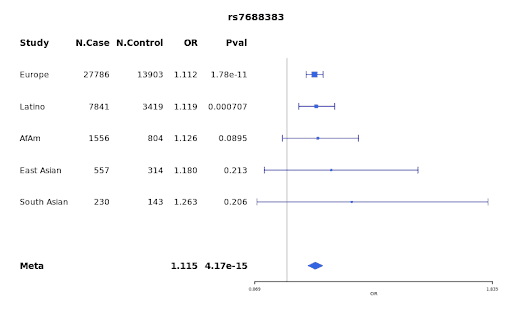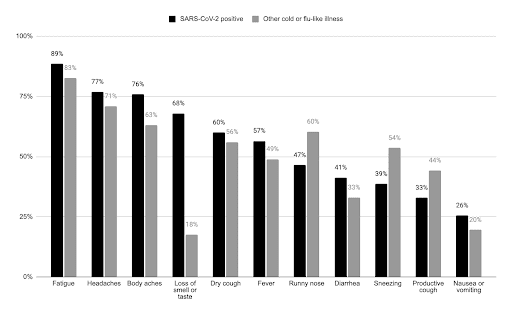Researchers at 23andMe have identified a new genetic variant associated with COVID-19 induced loss of smell and taste.
The findings, published in a preprint released on medRxiv, note that the genetic variant is near two olfactory genes. Loss of smell and, or taste — also called anosmia — is a hallmark symptom of COVID-19. It is often the earliest indication of infection, and in some cases, the only symptom. An individual with one copy of the variant is about 11.5 percent more likely to lose their sense of smell or taste if infected compared to someone with zero copies.
23andMe COVID-19 Study
The research adds another piece to the COVID-19 puzzle, and it builds on the work already done by 23andMe over the last year that includes new findings around the role blood type plays in severity and susceptibility to the virus. This piece of the puzzle is intriguing because the novel coronavirus SARS-CoV-2 first enters the body and accumulates in olfactory support cells. The findings may offer researchers important insights into the biological pathway for infection.
For these findings, the researchers again used data from more than one million people who consented to participate in 23andMe’s COVID-19 Study. By examining the differences in the genome between COVID-19 cases who did and did not experience loss of taste or smell, our scientists identified an association on chromosome 4 near the olfactory genes UGT2A1 and UGT2A2 (Figure 1 and Figure 2a).

Figure 1. Manhattan plot of loss of smell vs. no loss of smell among those with a positive SARS-CoV-2 test.
Relevant for All Ethnicities
The scientists ran separate genome-wide association studies for individuals of European, Latino, African American, East Asian, and South Asian ancestries, and then combined the data via a meta-analysis. The researchers evaluated the effect of the top-associated single nucleotide polymorphism (SNP) in the different ancestral populations (Figure 2).

Figure 2a. Regional plot of the association detected in the vicinity of UGT2A1/2.

Figure 2b. Population effect sizes and 95% confidence intervals.
Those results show no evidence of a difference in the SNP effect between populations, although there is limited power to detect associations in the non-European populations. Nonetheless, the frequency of the risk allele does differ somewhat by population. It is most commonly observed in individuals of European ancestry (37 percent) and least commonly observed in individuals of East Asian ancestry (19 percent) (Table 1).
| Population | Variant frequency |
| Europe | 37% |
| South Asian | 32% |
| African American | 31% |
| Latino | 30% |
| East Asian | 19% |
Table 1. Allele frequencies by population or rs7688383
Among the Most Common Symptoms
Early in the outbreak, the loss of smell and taste was recognized as a means to distinguish between patients with COVID-19 and those with simple colds or flu. That is, if you felt sick and had a loss of smell or taste, you were much more likely to have COVID-19 than another respiratory infection (1, 2).
In the 23andMe COVID-19 study, two-thirds (68 percent) of those who tested positive for the virus reported loss of smell or taste, compared to just 17 percent of those who tested negative (Figure 3). Furthermore, in a model adjusted for other symptoms, age, and sex, the loss of smell or taste carried a seven-fold increased likelihood of testing positive for SARS-CoV-2 among those reporting illness.

Figure 3. Frequency of symptoms reported among respondents with a cold or flu-like illness who did and did not have a positive SARS-CoV-2 result in the 23andMe study, ordered by percentage difference.
Looking by Age
When the researchers looked at the symptoms by age, they found that among younger people with COVID-19 the loss of smell and taste was more common. Among those aged 26-35, 73 percent reported loss of smell, whereas only 43 percent reported loss of smell in those 85 or older (Figure 4). When the researchers looked at differences between men and women they found that women were more likely than men to report loss of smell or taste (72 percent vs. 61 percent). While it is known that age is associated with lower sensitivity to smell, these findings held up when adjusted for self-reported ability to smell in advance of infection with SARS-CoV-2.

Figure 4. COVID-19 related loss of smell by age group
More About the Genetic Association
Little is known about what the genetic variant (rs7688383) does, or how it impacts the likelihood of losing your smell or taste during infection with SARS-CoV-2. But the olfactory genes UGT2A1/2 are part of a family of enzymes called uridine diphosphate glycosyltransferases and are expressed in the olfactory epithelium and metabolize odorant compounds. In the 23andMe database, both of these genes are related to such things as ice-cream taste preference and ability to smell as measured by a self-reported five-point scale ranging from very poor to very good.
Recent evidence suggests that SARS-CoV-2 enters and accumulates in olfactory support cells, which abundantly express the viral entry proteins ACE2 and TMPRSS2 (3, 4). It has been proposed that olfactory sensation is impaired when these essential functions are disrupted, causing olfactory receptor neuron cilial impairment (5). Given their localization and essential function in the metabolization and detoxification of compounds in the olfactory epithelium, the genes identified here, UGT2A1/2, may play a role in the physiology of infected cells and the resulting changes to the cilia that contribute to our ability to smell.
Many thanks to the over 1 million research participants who answered our questionnaire and made this research possible.
*The 23andMe COVID-19 research team includes: Adam Auton, Adrian Chubb, Alison Fitch, Alison Kung, Amanda Altman, Andy Kill, Anjali Shastri, Antony Symons, Catherine Weldon, Chelsea Ye, Daniella Coker, Janie Shelton, Jason Tan, Jeff Pollard, Jey McCreight, Jess Bielenberg, John Matthews, Johnny Lee, Lindsey Tran, Maya Lowe, Michelle Agee, Monica Royce, Nate Tang, Pooja Gandhi, Raffaello d’Amore, Ruth Tennen, Scott Dvorak, Scott Hadly, Stella Aslibekyan, Sungmin Park, Taylor Morrow, Teresa Filshtein Sonmez, Trung Le, and Yiwen Zheng.
[/vc_column_text][/vc_column][/vc_row]